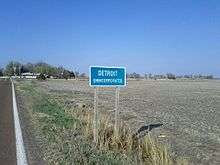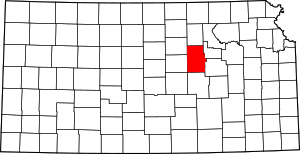Detroit, Kansas
Detroit is an unincorporated community in Dickinson County, Kansas, United States.[1] As of the 2010 census it had a population of 114.[2]
Detroit, Kansas | |
|---|---|
Old Detroit school house (2013) | |
 KDOT map of Dickinson County (legend) | |
 Detroit | |
| Coordinates: 38°56′6″N 97°7′15″W[1] | |
| Country | United States |
| State | Kansas |
| County | Dickinson |
| Area | |
| • Total | 0.34 sq mi (0.89 km2) |
| • Land | 0.34 sq mi (0.89 km2) |
| • Water | 0.0 sq mi (0.0 km2) |
| Elevation | 1,138 ft (347 m) |
| Population (2010) | |
| • Total | 114 |
| • Density | 330/sq mi (130/km2) |
| Time zone | UTC-6 (CST) |
| • Summer (DST) | UTC-5 (CDT) |
| Area code | 785 |
| FIPS code | 20-17875 [1] |
| GNIS ID | 485450 [1] |
History
The town was named after Detroit, Michigan.[3] In the early years of the county, Detroit was once strongly considered to be the county seat because Abilene was considered to be "too wild" of a town to serve as a center of government. However, Abilene became the county seat and Detroit ceased to grow from that point forward.[4]
A post office was opened in Detroit in 1866, and remained in operation until it was discontinued in 1961.[5]
Detroit was a station on the Union Pacific Railroad.[6]
Geography
Detroit is located halfway between Abilene and Chapman, 2 miles (3 km) north of Enterprise. The town is at an elevation of 1,147 feet (350 m) above sea level.[7]
Detroit is a "square" town, two blocks long and two blocks wide. The three north-south streets are Main, Middle, and School. The three east-west streets are First, Second, and Third. There are no more streets in Detroit. All six streets are unpaved.
Demographics
For statistical purposes, the United States Census Bureau has defined Talmage as a census-designated place (CDP).
Economics
At one time Detroit maintained an active store and grocery, a train depot, a nightclub, a school and a church. In recent years most buildings have collapsed or been renovated for use as a dwelling. The one exception is the pub. Although it has changed ownership and its official business name, locals have simply referred to it as "The Midway" or "The Beer Joint". Because of its proximity to the intersection of county roads, it has become a local landmark.
In 1898, a newspaper titled The Detroit Free Press attempted to build circulation. Records are not found past the first year of 1898.[8] It does not appear to have any connection to the Detroit Free Press published in Detroit, Michigan.[9]
Agriculture and agriculture-related businesses are the primary economic industries.
The United States Post Office operated a branch in Detroit that opened on April 6, 1866, and ceased operation on June 23, 1961.[10]
Education
The community is served by Chapman USD 473 public school district.
Gallery
 Detroit from the south, viewed from State Highway K-43
Detroit from the south, viewed from State Highway K-43- "The Beer Joint" or "The Midway"
References
- Geographic Names Information System (GNIS) details for Detroit, Kansas; United States Geological Survey (USGS); October 13, 1978.
- "Geographic Identifiers: 2010 Demographic Profile Data (G001): Detroit CDP, Kansas". U.S. Census Bureau, American Factfinder. Retrieved October 26, 2015.
- Heim, Michael (2007). Exploring Kansas Highways. p. 39.
- Cutler, William. "Dickinson County Early History". Kansas Collection of Books. Retrieved March 16, 2012.
- "Kansas Post Offices, 1828-1961 (archived)". Kansas Historical Society. Archived from the original on September 9, 2013. Retrieved 8 June 2014.
- Blackmar, Frank Wilson (1912). Kansas: A Cyclopedia of State History, Embracing Events, Institutions, Industries, Counties, Cities, Towns, Prominent Persons, Etc. Standard Publishing Company. pp. 516.
- "Blue Skyways". Archived from the original on 2008-03-24. Retrieved 2008-04-03.
- "About Detroit free press. (Detroit, Kan.) 1898-1898". National Endowment for the Humanities. Retrieved May 28, 2018.
- "About The Weekly Detroit free press. (Detroit, Mich.) 18??-1895". National Endowment for the Humanities. Retrieved May 28, 2018.
- "Kansas State Historical Society". Archived from the original on 2010-06-22. Retrieved 2008-04-03.
Further reading
External links
| Wikimedia Commons has media related to Detroit, Kansas. |
